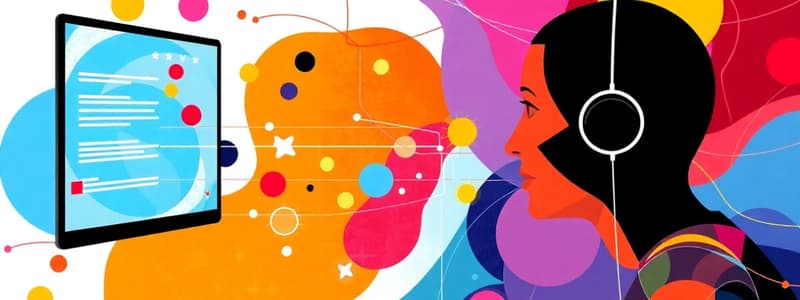Podcast
Questions and Answers
What does HCI primarily focus on?
What does HCI primarily focus on?
- Programming languages used in computing
- The interface between the human and computer (correct)
- The theory of machine learning algorithms
- The development of hardware components
What is the goal of Human-Computer Interaction?
What is the goal of Human-Computer Interaction?
- To create autonomous computing systems
- To standardize programming languages
- To improve the usability of computer interfaces (correct)
- To minimize user involvement in computing tasks
Which of the following channels is NOT typically considered an input channel?
Which of the following channels is NOT typically considered an input channel?
- Vision
- Touch
- Processing speed (correct)
- Hearing
What constraint should be prioritized in the design of computer systems?
What constraint should be prioritized in the design of computer systems?
Which aspect of human cognition is emphasized in HCI?
Which aspect of human cognition is emphasized in HCI?
Which term refers to the user at the center of HCI design?
Which term refers to the user at the center of HCI design?
Which of the following models or components is NOT a focus of HCI?
Which of the following models or components is NOT a focus of HCI?
What is the significance of considering individual differences in HCI?
What is the significance of considering individual differences in HCI?
What type of memory is used for storing information momentarily before it is transferred to long-term memory?
What type of memory is used for storing information momentarily before it is transferred to long-term memory?
What is the primary channel through which users receive information from a computer?
What is the primary channel through which users receive information from a computer?
Which of the following factors contributes to visual perception of size and depth?
Which of the following factors contributes to visual perception of size and depth?
What is a recommended font size range for optimal legibility on a computer screen?
What is a recommended font size range for optimal legibility on a computer screen?
How does negative contrast affect reading speed from a computer screen?
How does negative contrast affect reading speed from a computer screen?
Which output method is NOT typically used by users when interacting with computers?
Which output method is NOT typically used by users when interacting with computers?
What is considered an important factor for reading recognition?
What is considered an important factor for reading recognition?
Which type of memory deals with the processing of information through reasoning and problem solving?
Which type of memory deals with the processing of information through reasoning and problem solving?
What is the primary function of hearing in relation to environmental awareness?
What is the primary function of hearing in relation to environmental awareness?
Which of the following statements correctly describes the response time to stimuli?
Which of the following statements correctly describes the response time to stimuli?
How does Fitts' law impact the design of interactive systems?
How does Fitts' law impact the design of interactive systems?
What are the four stages involved in processing a simple action like hitting a button?
What are the four stages involved in processing a simple action like hitting a button?
Which aspect does reaction time depend on?
Which aspect does reaction time depend on?
What role does touch play for individuals who are visually impaired?
What role does touch play for individuals who are visually impaired?
What does Fitts' law indicate about movement time in relation to target size?
What does Fitts' law indicate about movement time in relation to target size?
In which scenario might fast reaction time reduce accuracy?
In which scenario might fast reaction time reduce accuracy?
What is the primary role of sensory memory?
What is the primary role of sensory memory?
Which of the following statements accurately describes short-term memory?
Which of the following statements accurately describes short-term memory?
What method can effectively facilitate the transfer of information from short-term memory to long-term memory?
What method can effectively facilitate the transfer of information from short-term memory to long-term memory?
Which factor is NOT important for remembering information in long-term memory?
Which factor is NOT important for remembering information in long-term memory?
How is information most easily retrieved from long-term memory?
How is information most easily retrieved from long-term memory?
What is a key characteristic of the processes involved in reasoning?
What is a key characteristic of the processes involved in reasoning?
Which of the following statements about the transfer of information from sensory memory to short-term memory is true?
Which of the following statements about the transfer of information from sensory memory to short-term memory is true?
Which type of reasoning derives logically necessary conclusions from given premises?
Which type of reasoning derives logically necessary conclusions from given premises?
What is the primary function of inductive reasoning?
What is the primary function of inductive reasoning?
Which type of reasoning involves inferring a cause from an event?
Which type of reasoning involves inferring a cause from an event?
What are slips in the context of human errors?
What are slips in the context of human errors?
How does positive affect typically influence problem-solving capabilities?
How does positive affect typically influence problem-solving capabilities?
Which of the following is a long-term individual difference among users?
Which of the following is a long-term individual difference among users?
What is the effect of negative affect on problem-solving tasks?
What is the effect of negative affect on problem-solving tasks?
In the context of design, what does the effect of stress imply for users?
In the context of design, what does the effect of stress imply for users?
What contributes to making a person’s goals incorrect leading to mistakes?
What contributes to making a person’s goals incorrect leading to mistakes?
Study Notes
Human Computer Interaction
- Human Computer Interaction (HCI) is the study of designing, implementing, and evaluating interactive computing systems for human use.
- The focus is on the interface between the human and the computer.
- The goal of HCI is to improve usability of computer interfaces and improve the interaction between humans and computers.
The Human
- Information is received and sent via various input and output channels:
- Visual
- Auditory
- Haptic
- Movement
- Information is stored in memory:
- Sensory Memory
- Short-term Memory
- Long-term Memory
- Information is processed and applied to:
- Reasoning
- Problem Solving
- Skill Acquisition
- Error
Interacting with Computers
- Users' receive information from the computer through sensory input (vision, hearing, touch, taste, and smell).
- Users' send information to the computer via movement (limbs, fingers, eyes, head, vocal system).
Input - Output Channels
- Users' input from the computer is received through their senses.
- Users' output to the computer is sent via their physical actions.
Vision
- The human eye perceives light and translates it into visual information.
- This involves two stages: physical reception of stimulus and visual perception.
Visual Perception
- Visual perception helps perceive size and depth:
- Visual Angle
- Depth
- Familiarity
- Brightness is affected by luminance and contrast.
- Color is defined by hue, intensity, and saturation.
Capabilities and Limitations of Visual Processing
- Humans can use context to resolve ambiguity in visual information.
Reading
- Adults read approximately 250 words per minute.
- The speed at which text can be read is called legibility.
- Word shape contributes to recognition.
- Reading from a computer screen is slower than reading a book.
- Standard font sizes of 9 to 12 points are equally legible on a screen.
- Negative contrast (dark characters on a light screen) improves reading from a computer screen.
Hearing
- Provides information about the environment.
- The auditory system filters sounds, allowing humans to focus on important information while ignoring background noise.
- In an interface, sound can be used to draw attention, provide status information, and confirm actions.
Touch
- Provides important feedback about the environment.
- Some areas of the body are more sensitive than others.
Movement
- A simple action, like hitting a button in response to a question involves multiple processing stages:
- Stimulus reception (question) and transmission to the brain.
- Processing the question in the brain.
- Generating a response.
- The brain instructing muscles to respond to the stimulus.
Response Time
- The time it takes to respond to a stimulus is called response time.
- Response time = reaction time + movement time.
- Age, fitness, and stimulus type affect response time.
- For unskilled users, fast reaction times can reduce accuracy, but not for skilled users.
Fitts’ Law
- Describes the time it takes to hit a target on a screen:
- Movement time = a + b log2(Distance/Target size + 1)
- "a" and "b" are constants determined empirically.
- Fitts’ law can affect target and menu design.
Human Memory
- Memory consists of sensory memory, short-term memory, and long-term memory.
- Sensory Memory is the shortest-term memory and acts as a buffer for stimuli. Information is transferred to Short-term Memory through attention.
- Short-term Memory (STM) has a limited capacity of 7+-2 chunks. The easier it is to group information or assign meaning, the better it is remembered.
- Long-term Memory (LTM) is where knowledge is stored. Information in STM can be transferred to LTM through rehearsal. This information can be retrieved through recall and recognition.
Thinking: Reasoning and Problem Solving
- Reasoning involves using existing knowledge to draw conclusions or infer new information.
- There are three types of reasoning:
- Deductive Reasoning: deriving logically necessary conclusions from given premises.
- Inductive Reasoning: generalizing from observed cases to unobserved cases.
- Abductive Reasoning: reasoning from event to cause.
- Problem solving is finding a solution to an unfamiliar task using existing knowledge.
Errors and Mental Models
- Humans make mistakes.
- Types of errors:
- Slips: occur when the right intention is carried out incorrectly.
- Mistakes: occur when the wrong goal or intention is chosen.
- Mental models are our internal representations of how something works. If our mental model is incorrect, we are more likely to make mistakes.
Emotion
- Emotion influences human capabilities.
- Affect is the biological response to physical stimuli.
- Emotion is an affective state induced by a specific stimulus.
- Positive affect can lead to creative problem solving; Negative affect can lead to narrow thinking.
- Implications for interface design:
- Stress makes problem solving more difficult.
- Relaxed users are more forgiving of design shortcomings.
Individual Differences
- Users share basic capabilities but are individuals with differences.
- Differences can be:
- Long term: gender, physical, and intellectual abilities.
- Short term: effect of stress or fatigue.
- Changing: age.
Psychology & the Design of Interactive Systems
- Apply knowledge of human psychology to design interactive systems.
Studying That Suits You
Use AI to generate personalized quizzes and flashcards to suit your learning preferences.
Related Documents
Description
This quiz provides an overview of Human Computer Interaction (HCI), focusing on the designs and evaluations of interactive systems. It covers how humans interact with computers through various input and output channels. Understanding these concepts aims to enhance usability and improve the interaction between humans and technology.




